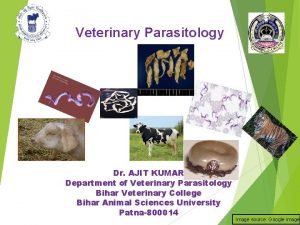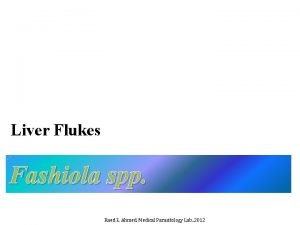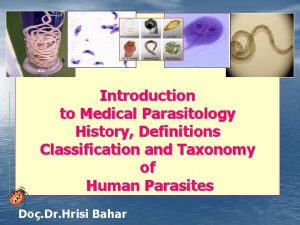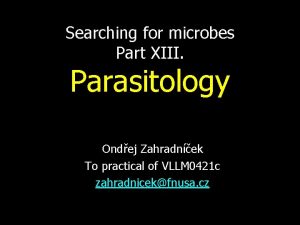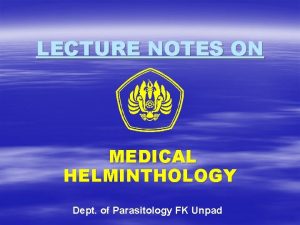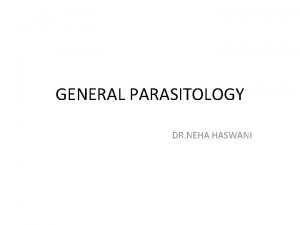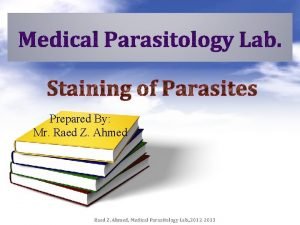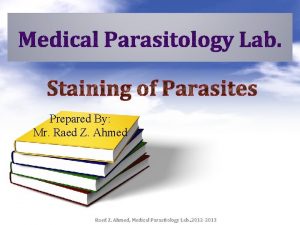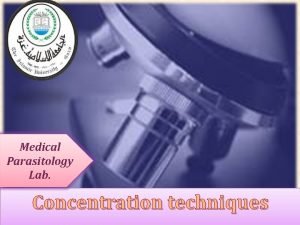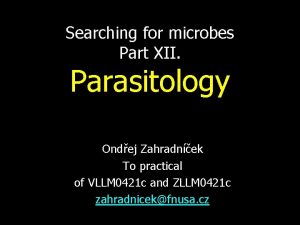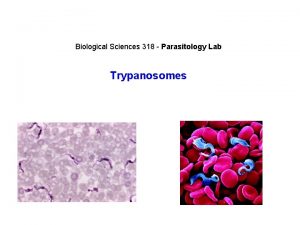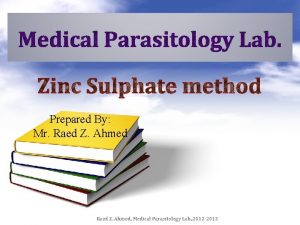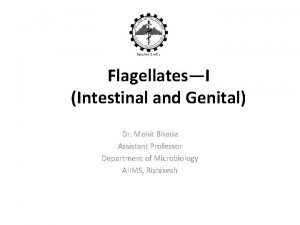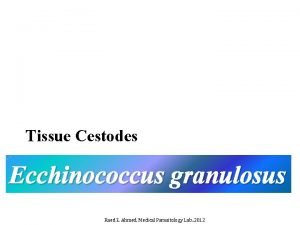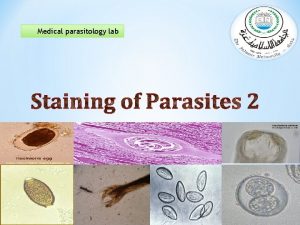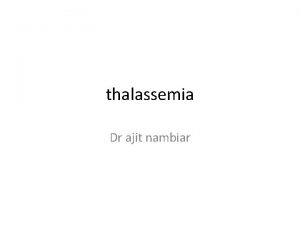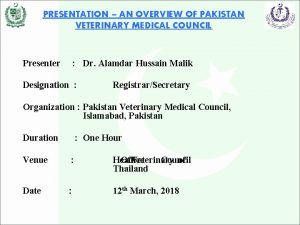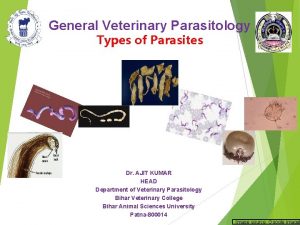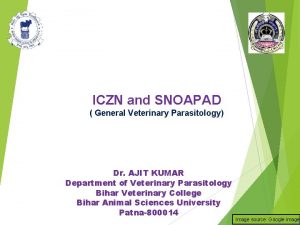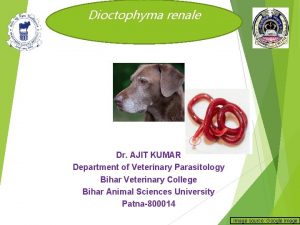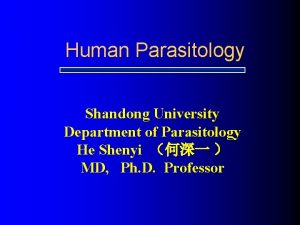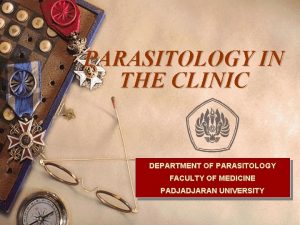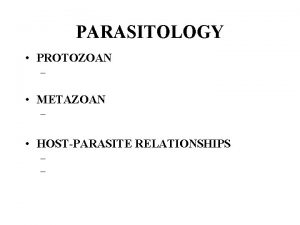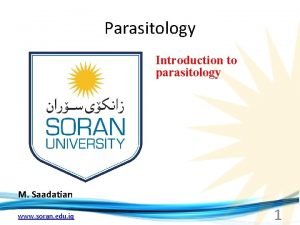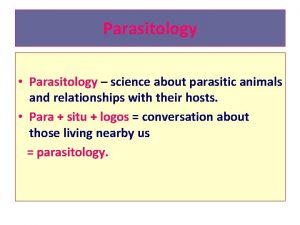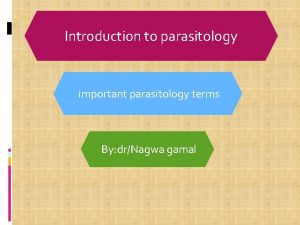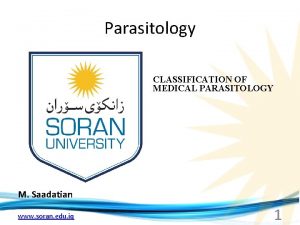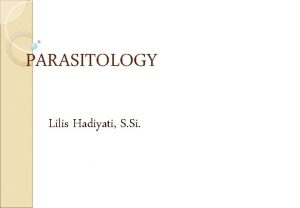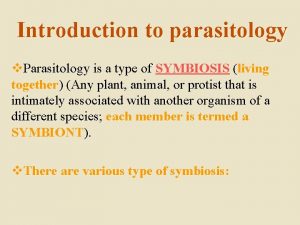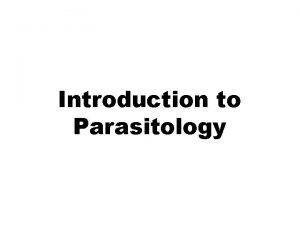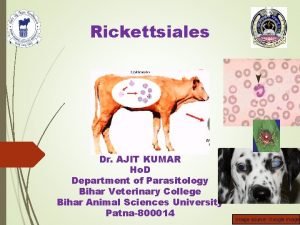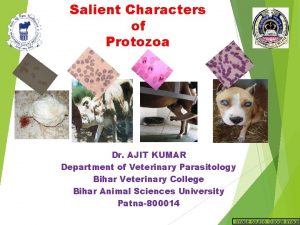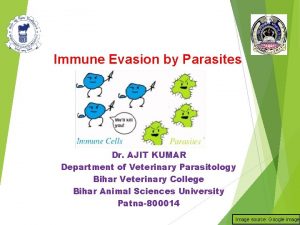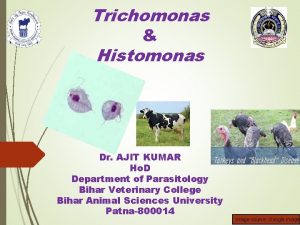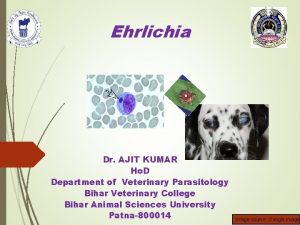Veterinary Parasitology Dr AJIT KUMAR Department of Veterinary






















- Slides: 22

Veterinary Parasitology Dr. AJIT KUMAR Department of Veterinary Parasitology Bihar Veterinary College Bihar Animal Sciences University Patna-800014 Image source: Google image

VETERINARY PARASITOLOGY v. Parasitology: The Branch of science which deals the phenomenon of parasitism. v. Veterinary Parasitology is a branch of animal science which provides knowledge of taxonomy, morphology, biochemistry, physiology, cell biology, immunology, pharmacology, pathogenesis including symptoms seen in hosts, method of diagnosis, treatment and control of parasites and diseases caused by parasites in animals and birds. Image source: Google image

VETERINARY PARASITOLOGY Ø Parasite: The word parasite is derived from the Greek word (Para means beside and sitos means food). An animal species which live in or on a large animal (host) and dependent metabolically on it. Ø The main aim of parasite is to live and let live because death of host causes death of parasite. Image source: Google image

Veterinary Parasitology Course Name Units Credit Hrs Unit- 1 ( General Veterinary Parasitology Unit-2 (Trematodes and Cestodes of Veterinary Importance) Unit-3 (Nematodes Importance) Unit- 4 (Arthropods Importance) Unit-5 (Protozoa Importance of of of Veterinary 3+2

General Veterinary Parasitology (Unit-1) v Introduction, v Important Historical land marks, v Types of Parasites v Types of hosts Types of Animal Association v Modes of transmission of Parasites v SNOAPAD v Immunity against parasitic infections/infestations v General Harmful effects of Parasites v General Control measures against parasites v Characters of various phyla of parasites Image source: Google image

Trematodes and Cestodes of Veterinary Importance (Unit-2) v Trematodes: Introduction , general account and classification, general life cycle of trematodes with morphological features of their developmental stages, important morphological features, life cycle, modes of transmission, pathogenesiss, diagnosis and general control measures of trematode parasites. Image source: Google image

Trematodes and Cestodes of Veterinary Importance (Unit-2) v Cestodes: Introduction , general account and classification, general life cycle of trematodes with morphological features of their developmental stages, important morphological features, life cycle, modes of transmission, pathogenesis, epidemiology, diagnosis and management of cestode parasites

Nematodes of Veterinary Importance (Unit-3) v Nematodes: Introduction , general account and classification, general life cycle of cestodes with morphological features of their developmental stages, important morphological features, life cycle, modes of transmission, pathogenesis, epidemiology, diagnosis and management of nematode parasites Image source: Google image

Arthropods of Veterinary Importance (Unit-4) v Arthropods : Introduction , general account and classification, general life cycle of arthropods with morphological features of their developmental stages, important morphological features, life cycle, Vector potentiality, pathogenesis, and control of arthropods affecting animals and birds. Image source: Google image

Protozoa of Veterinary Importance (Unit-5) v Protozoa: Introduction , general account and classification, general life cycle of protozoa with morphological features of their developmental stages, Differentiation from bacteria and rickettsia, important morphological features, life cycle, modes of transmission, pathogenesis, epidemiology, diagnosis and control of protozoan parasites of veterinary and zoonotic importance. Trypanosoma sp. in blood plasma Babesia sp. inside RBCs Image source: Google image

Veterinary Parasitology Internal Assessment Examination Internal Assessment Maximum Marks Weightage First 40 10 Second 40 10 Third 40 10 the result of the best of two Results of the best of two Internal Assessments shall be accounted

Veterinary Parasitology Annual Examination Papers Theory Practical Units Maximum Weightag Marks e Paper-I Units- 1, 2, 100 &3 20 Paper- II Units- 4 & 5 20 Paper-I Units- 1, 2, 60 &3 20 Paper- II Units- 4 & 5 20 100 60

Text Books of Veterinary Parasitology v Helminths , Arthropods and Protozoa of Domesticated Animals – E. J. L. Soulsby v Veterinary Parasitology- G. M. URQUHRT, J. ARMOUR, J. L. DUNCAN, A. M. DUNN, F. W. JENNINGS v Text Book of Veterinary Parasitology - B. B. Bhatia, K. M. L. Pathak, P. D. Juyal

History of Parasites Francisco Redi is considered as Grand father or Founder of Parasitology. 1674 – A. V. Leeuwenhoek observed first parasitic protozoa i. e. Eimeria stiedae from the gall bladder of rabbit. 1681 - A. V. Leeuwenhoek also first observed Giardia lamblia from his own stool. Image source: Google image Giardia

History of Parasites 1849 - Gross described first parasitic amoeba, Entamoeba gingivalis in the human mouth. 1878 – Lewis first time reported the mammalian trypanosome, Trypanosoma lewisi in rats. 1880 - C. L. A. Laveran first discovered the human malarial parasite i. e. Plasmodium malariae. C. L. A. Laveran Image source: Google image

History of Parasites 1880 – Griffith Evans discovered first pathogenic trypanosome, Trypanosoma evansi from blood of horses and camels suffering from ‘surra’. Trypanosoma evansi Griffith Evans Image source: Google image

History of Parasites 1893 - Theobald Smith and Kilbourne first documented the transmission of a disease agent by an arthropod and described the transmission of Babesia bigemina (caused Texas cattle fever) by the cattle tick, Boophilus microlus. Theob Smithald 1894 -99 – Alfred Lingard made chemotherapeutic studies against Surra with arsenicals which were emulated by Ehrlich to treat syphilis in human beings. Image source: Google image

History of Parasites 1897 – Ronald Ross found Female Anopheles mosquito as the vector of human malarial parasites and got Nobel Prize. 1898 – Ronald Ross observed Culex fatigans as the vector of bird malaria parasite, Plasmodium relictum. Plasmodium sp. Female Anopheles 1902 – Graham found Aedes aegypti as vector for Dengue fever. Image source: Google image

History of Parasites 1903 – Leishman and Donovan independently discovered Leishmania donovani in spleen smears of a soldier who died of a fever at Dum (W. Bengal), the cause of Kala azar. W. B. Leishman and Charles Donovan Amastigote stage of Leishmania donovani

History of Parasites 1928 - Stoll showed “Self-cure” phenomena in sheep infected with the Haemonchus contortus 1959 -63 – Jarett and co-workers introduced first commercially antiparasitic vaccine (Dictol) against lungworms in sheep and cattle. 1989 -94 - Rand, Rodriquez and other workers commercialized recombinant tick vaccine (“Tick Guard” and “Guvac”). Image source: Google image

History of Parasites 1932 -33 - M. A. N Rao discovered Schistosoma nasale from veins of nasal mucosa of cattle. Parthasarathy Naidu treated nasal granuloma disease with Antimonium tartarate in 1921. Schistosoma nasale P. G. Pandey described Stephanofilaria assamensis as causative worm of “Hump Sore” in cattle. 1935 -36 - Hump sore Image source: Google image

History of Parasites 1950 - H. N. Ray described Stilbamidine test as a diagnostic tool for latent trypanosomosis in bovines. 1958 - S. N. Singh described Stephanofilaria zaheeri as causative agent of “Ear Sore” in buffaloes. 1988 - J. P. Dubey and co-workers discovered Neospora caninum. J. P. Dubey
 Father of veterinary parasitology
Father of veterinary parasitology Raed eggs
Raed eggs Introduction to parasitology
Introduction to parasitology Toxoplaxmosis
Toxoplaxmosis Dyphilidium caninum
Dyphilidium caninum General parasitology lecture notes
General parasitology lecture notes Definition of parasitology
Definition of parasitology Parasitology
Parasitology Ancylostoma
Ancylostoma Sedimentation technique for stool concentration
Sedimentation technique for stool concentration Emaplex
Emaplex Parasitology
Parasitology Parasitology
Parasitology Zinc sulphate technique in parasitology
Zinc sulphate technique in parasitology Essentials of medical parasitology
Essentials of medical parasitology Parasitology
Parasitology Cryptosporidium parvum
Cryptosporidium parvum Hair on end appearance x ray
Hair on end appearance x ray Rishabh ajit sambhav abhinandan
Rishabh ajit sambhav abhinandan Dr ajit saxena
Dr ajit saxena Extremal graph
Extremal graph Dr ajit singh
Dr ajit singh Brigadier ajit millu
Brigadier ajit millu
